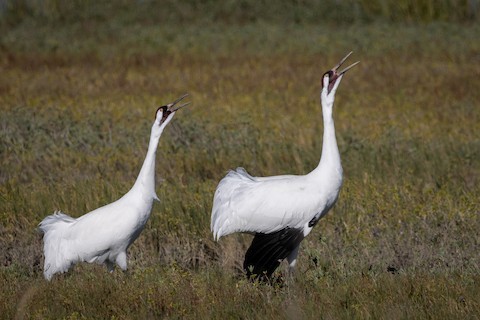Birdfinding.info ⇒ Rare and endangered, but increasing, the Whooping Crane can be found from mid-November to mid-April at Aransas National Wildlife Refuge, most readily seen from boats that leave from Rockport.
Whooping Crane
Grus americana
A small remnant native population breeds in north-central Canada and winters along the coast of Texas. Two additional populations have been successfully reintroduced: one breeds in central Wisconsin and winters in western Florida; the other is resident in southwestern Louisiana.
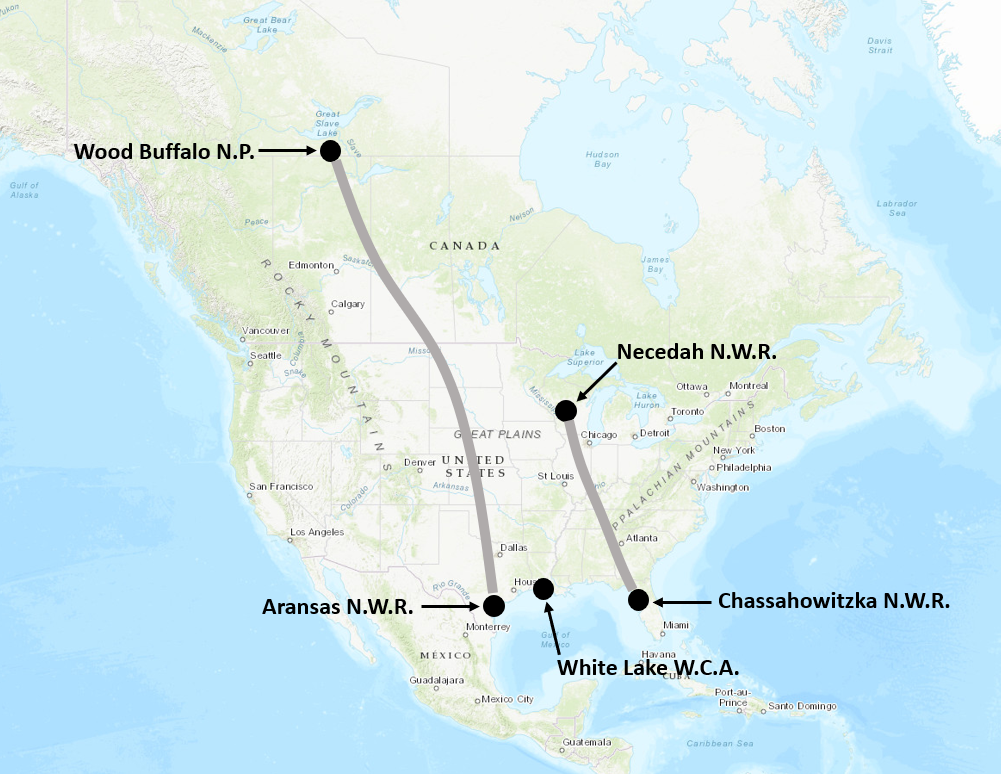
Approximate distribution of the Whooping Crane.
Rescued from imminent extinction through the heroic interventions of conservation biologists, the Whooping Crane has rebounded from a low of 15 or 16 individuals in 1941-42 to a global total of over 800 in the early 2020s. As of 2021, the International Crane Foundation tallied 802 individuals in five populations: 506 in the Canadian migratory flock; 81 in the Wisconsin migratory flock; 72 in the Louisiana nonmigratory flock; 7 in a dwindling experimental flock in the Kissimmee Prairie of central Florida; and 136 in captivity.
Breeding. The remnant native population nests in remote marshlands along the Little Buffalo River and its western tributaries in Wood Buffalo National Park in the southern Northwest Territories and adjacent northern Alberta.

Whooping Crane nesting grounds in Wood Buffalo National Park. U.S. Fish and Wildlife Service. 2007
One reintroduced population nests in the Great Central Swamp of Wisconsin around Necedah National Wildlife Refuge. Starting in 2001, a total of 76 captive-hatched juveniles have been released at Necedah. This population first nested in 2005, fledged its first juveniles in 2006, and appears to have become self-sustaining.
Another successfully reintroduced population nests on the coastal plain of southwestern Louisiana. This reintroduction effort began at White Lake Wetlands Conservation Area in Vermilion Parish in 2011. Birds from this population have dispersed to nearby areas in Allen, Avoyelles, and Cameron Parishes.
As recently as the 1800s, the Whooping Crane bred across a large swath of central and eastern North America, from the northern prairies of Canada southeast to northern Iowa and Illinois. A secondary eastern population bred in wetlands along the southern portion of Hudson Bay and James Bay. Non-migratory populations bred along the coastal plain of the Gulf of Mexico from eastern Texas to Florida.
Nonbreeding. The Canada-breeding population winters along the central coast of Texas in and around Aransas National Wildlife Refuge (the Blackjack Peninsula), where it forages in estuarine marshes, shallow bays, and tidal flats sheltered by barrier islands, south to Aransas Pass and northeast to Espiritu Santo Bay.
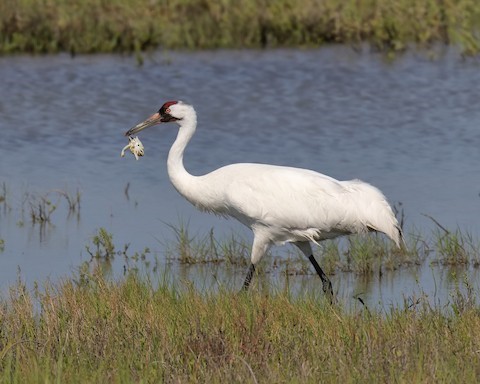
Whooping Crane holding its favored winter prey, a Blue Crab. (Aransas National Wildlife Refuge, Texas; March 21, 2019.) © Ian K. Barker
The reintroduced Wisconsin-breeding population winters along the western coast of Florida in and around Chassahowitska National Wildlife Refuge. The reintroduced Louisiana-breeding population is nonmigratory.
Historical wintering grounds were mainly along coasts of the southeastern U.S.: along the Atlantic Coast from New Jersey to Florida and along the Gulf of Mexico from Tamaulipas to Florida. The last report from Tamaulipas was in February 1951.
Movements. The Canada-breeding population departs from Aransas in the latter half of April and arrives at Wood Buffalo two to four weeks later. The migration route is direct over the Great Plains to western North Dakota, then bends more northwesterly across Saskatchewan and northeastern Alberta. A database of sightings shows a migration corridor that is approximately 200 miles wide.
The southbound migration begins in mid-September and lasts for approximately six to eight weeks, essentially retracing the northbound route. Most of the population begins by flying from Wood Buffalo to west-central Saskatchewan, then remains there for two to four weeks eating grain and storing energy before completing the journey to Texas.
The reintroduced Wisconsin-breeding population was trained to migrate to its Floridian wintering grounds. To achieve this result, a team of biologists released captive-hatched juveniles at Necedah, then acclimated them to flying behind ultralight aircraft, then used the aircraft to guide them along a pre-planned route through Illinois and across the southern end of the Appalachians. This population migrates north in late March, arriving in early April, and makes the return trip from late October into November.
Identification
Unique in its range: a very tall white crane with a black-and-red mask. The tallest bird in North America, reaching approximately 150 cm or 5 feet in height.
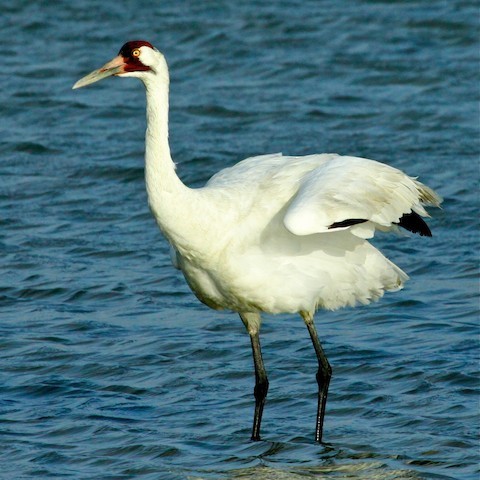
Whooping Crane. (Aransas National Wildlife Refuge, Texas; March 22, 2011.) © Rob O’Donnell
The plumage is almost entirely white, except for black primaries which are visible only when the wings are spread.
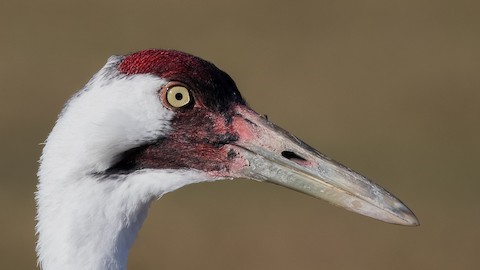
Whooping Crane, facial close-up showing red-and-black skin with sparse hairlike black feathers. (Backbone Road, Polk County, Florida; January 15, 2021.) © Lynette Spence
The black-and-red mask is bare or nearly bare skin that extends from the face back over the crown and also as a bold whisker stripe. The bill is dull grayish or horn-colored with a pinkish base.
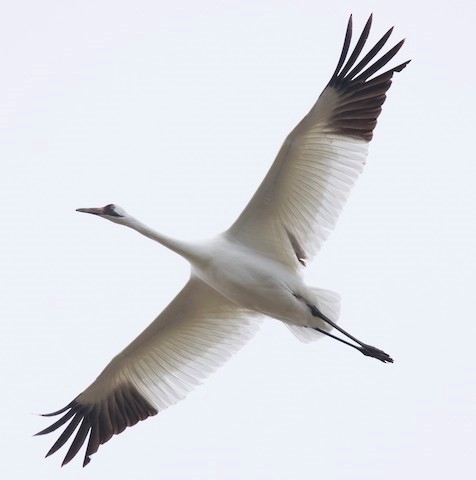
Whooping Crane in flight showing black primaries. (Lake Thunderbird State Park, Oklahoma; October 20, 2020.) © Cody Delano

Whooping Crane in flight showing black primaries and primary coverts. (Backbone Road, Polk County, Florida; December 20, 2017.) © Peter Brannon
Juveniles have rusty-orangish plumage over the head, neck, and patchily throughout the upperparts, but are otherwise white.
On older immatures, the rusty feathers are replaced by white ones, as the facial feathers fall out to leave the bare skin mask.
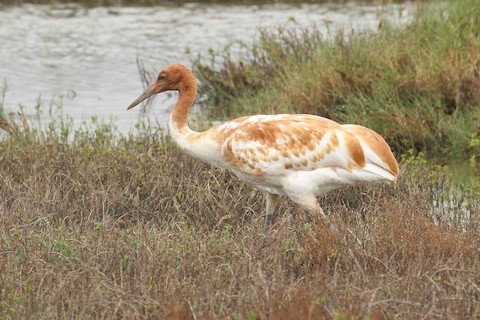
Whooping Crane, juvenile showing rusty plumage. (Aransas National Wildlife Refuge, Texas; November 12, 2017.) © Donna Pomeroy
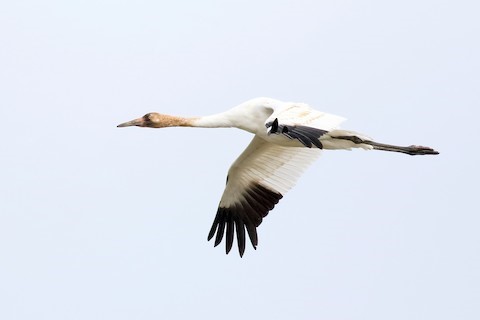
Whooping Crane, immature in flight. (Goose Island State Park, Texas; January 23, 2022.) © Sam Zhang
Notes
Monotypic species.
IUCN Red List Status: Endangered.
More Images of the Whooping Crane

Whooping Crane. (Aransas National Wildlife Refuge, Texas; November 17, 2019.) © Steve Coggin
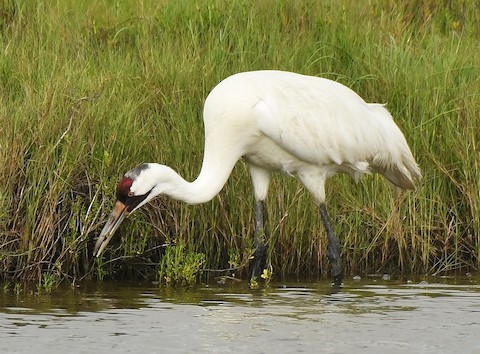
Whooping Crane. (Aransas National Wildlife Refuge, Texas; March 19, 2020.) © Rachel Hudson
References
Alderfer, J., and J.L. Dunn. 2014. National Geographic Complete Birds of North America (Second Edition). National Geographic Society, Washington, D.C.
BirdLife International. 2020. Grus americana. The IUCN Red List of Threatened Species 2020: e.T22692156A181242855. https://dx.doi.org/10.2305/IUCN.UK.2020-3.RLTS.T22692156A181242855.en. (Accessed October 22, 2022.)
eBird. 2022. eBird: An online database of bird distribution and abundance. Cornell Lab of Ornithology, Ithaca, N.Y. http://www.ebird.org. (Accessed October 22, 2022.)
Howell, S.N.G., and S. Webb. 1995. A Guide to the Birds of Mexico and Northern Central America. Oxford University Press.
Hughes, J.M. 2008. Cranes: A Natural History of a Bird in Crisis. Firefly Books, Richmond Hill, Ontario.
International Crane Foundation. 2022. Species Field Guide: Whooping Crane. https://savingcranes.org/learn/species-field-guide/whooping-crane/. (Accessed October 22, 2022.)
Salt, W.R., and J.R. Salt. 1976. The Birds of Alberta. Hurtig Publishers, Edmonton, Alberta.
Sibley, D.A. 2014. The Sibley Guide to Birds (Second Edition). Alfred A. Knopf. New York.
U.S. Fish and Wildlife Service. 2007. International Recovery Plan for the Whooping Crane (Grus americana) (Third Revision), March 2007. https://savingcranes.org/wp-content/uploads/2022/05/whooping_crane_recovery_plan.pdf.
Xeno-Canto. 2022. Whooping Crane – Grus americana. https://xeno-canto.org/species/Grus-americana. (Accessed October 22, 2022.)
